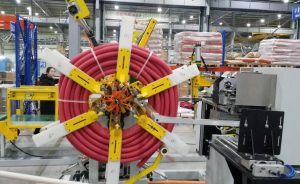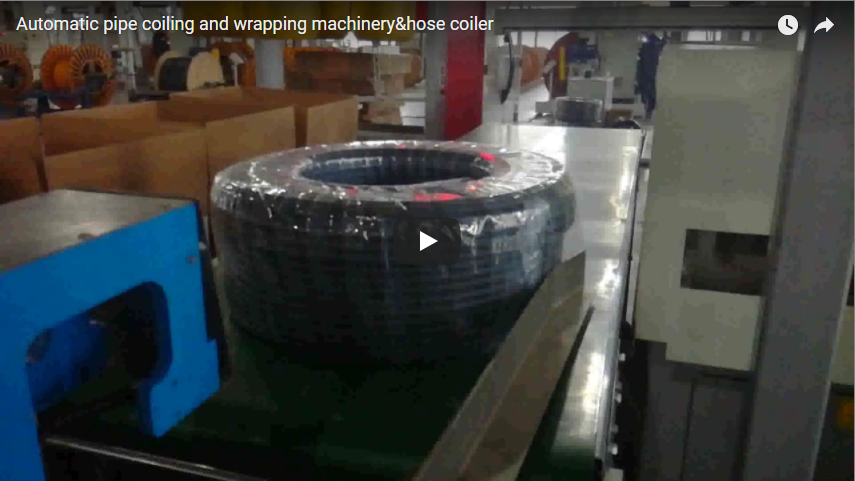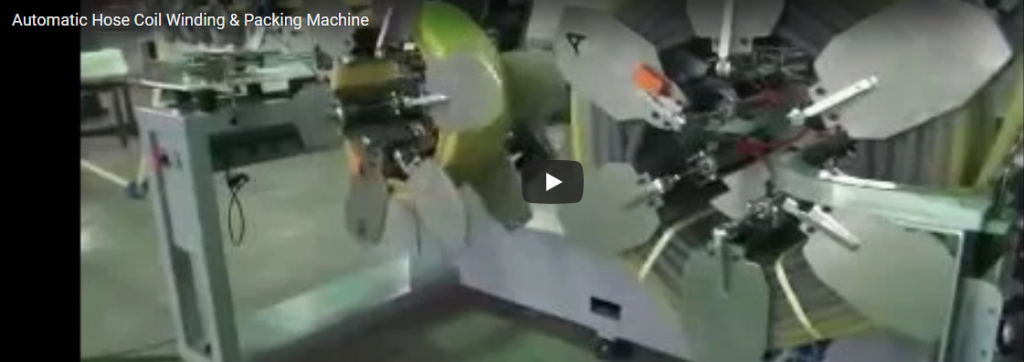In today's demanding industrial and commercial landscapes, efficiency and consistency in packaging are paramount. For businesses dealing with hoses – from garden suppliers to heavy industry – the manual process of coiling and wrapping is often a bottleneck, prone to inconsistencies and labor-intensive. Enter the Automatic Hose Winding and Wrapping Machine: a sophisticated solution engineered to streamline this crucial final step in production or preparation. This technology not only accelerates packaging operations but also enhances product presentation, protection, and handling readiness. Let's delve into the technical intricacies, operational benefits, and user considerations of these indispensable machines.

1. Unpacking the Workflow: How the Automatic Hose Winder & Wrapper Operates
Understanding the automated sequence reveals the efficiency gains offered by these machines. While specific configurations vary, a typical operational cycle involves:
- Hose Feeding: The machine carefully draws the hose from the source (e.g., extruder line or bulk reel). Precision guides ensure correct alignment.
- Measuring & Cutting (Optional): Integrated sensors measure the desired length. Some models incorporate an automated cutting mechanism for precise hose lengths before winding.
- Winding/Coiling: The hose is expertly wound onto a retractable mandrel or coiling head. Sophisticated tension control systems ensure a tight, uniform coil without damaging the hose structure. Coil diameter and traverse width are precisely managed.
- Coil Transfer: Once wound, the coil is automatically transferred from the winding station to the wrapping station. This might involve robotic arms or conveyor systems.
- Wrapping: The wrapping unit applies protective material, typically stretch film or strapping bands (like PP or PET). The coil often rotates on a turntable or rollers as the wrapping head dispenses and tensions the film/strap, ensuring complete and secure coverage. Overlap percentages and wrapping patterns are usually programmable.
- Ejection/Discharge: The finished, wrapped coil is automatically ejected onto an output conveyor or designated collection area, ready for palletizing or shipment.
2. Engineering Excellence: Design Philosophy and Structural Build
The performance and longevity of an automatic hose winding and wrapping machine are rooted in its design and construction:
- Robust Frame: Typically built with heavy-gauge steel, engineered for stability and vibration damping during high-speed operation. This ensures consistent performance and minimizes wear and tear.
- Component Materials: Contact parts are often made from materials chosen to prevent hose damage (e.g., smooth rollers, non-abrasive guides). Durability is key, with high-quality bearings, motors, and pneumatic or hydraulic components.
- Modular Design: Many modern machines feature a modular design, allowing for easier customization, maintenance, and potential future upgrades (e.g., adding different wrapping options or labeling units).
- Adaptability: Design considerations accommodate a range of hose diameters, lengths, weights, and materials (from flexible PVC garden hoses to rigid hydraulic hoses). Adjustments are often tool-less or automated via the control system.
3. Anatomy of Automation: Key Component Breakdown
Several critical subsystems work in concert:
- Hose Handling & Feeding System: This includes dancers or accumulators for tension control, precise guide rollers, and often sensors to detect hose presence and movement. Accuracy here prevents slack or excessive tension during winding.
- Precision Winding Module: The heart of the coiling process. Features include the coiling head/mandrel design (collapsible segments for easy coil removal), variable speed drive motors for controlled acceleration/deceleration, and sophisticated tension feedback loops (using load cells or motor torque monitoring).
- Secure Wrapping Unit: This subsystem features the film carriage or strapping head, pre-stretch rollers (for stretch film savings and load stability), automated film cutting and clamping mechanisms, and precise control over wrap counts and tension.
- Intelligent Control System (PLC/HMI): Usually managed by a Programmable Logic Controller (PLC) and operated via a user-friendly Human-Machine Interface (HMI) touchscreen. This allows operators to:
- Set parameters (hose length, coil ID/OD, winding tension, wrapping program).
- Store and recall multiple product recipes.
- Monitor machine status in real-time.
- Access diagnostics and troubleshooting guides.
- Integrated Safety Features: Essential for operator protection and compliance. Standard features include physical guarding with interlocked access doors, emergency stop buttons at multiple points, light curtains in hazardous areas, and overload protection for motors, adhering to standards like CE or OSHA.
4. Technical Specifications Profile (Model HWWM-880 Example)
The following specifications provide an illustrative example of what such a machine might offer.
Important Note: The parameters listed below are for a representative model (HWWM-880) and may not perfectly match the specific equipment shown in the video. For exact specifications tailored to your needs, please contact us directly.
| Feature | Specification | Notes |
|---|---|---|
| Machine Type | Fully Automatic Hose Winding & Wrapping | Integrated coiling and stretch wrapping/strapping capability |
| Model | HWWM-880 | Representative example |
| Year of Manufacture | 2023 (Example) | Reflects modern design principles |
| Hose Diameter Range | 20mm – 200mm | Indicates versatility across different hose types |
| Max. Coil Diameter | 600mm | Defines the maximum size of the finished coil |
| Wrapping Materials | Stretch Film, Plastic Straps | Offers flexibility in packaging choice |
| Output Capacity | Up to 15 coils/hour | Dependent on hose length, diameter, and wrapping complexity |
| Winding Speed | Variable (e.g., up to 100 m/min) | Programmable based on hose type and coil parameters |
| Wrapping Speed | Variable (e.g., up to 30 RPM) | Adjustable rotation speed for optimal film/strap application |
| Tension Control | Automatic (Winding & Wrapping) | Ensures consistent coil tightness and secure wrap |
| Power Supply | 380V, 50Hz, 3-Phase (Typical) | Check local requirements; other voltages/frequencies available |
| Machine Dimensions | L: 3500mm; W: 2200mm; H: 2000mm | Approximate footprint; varies with configuration |
| Control System | Advanced PLC with Touchscreen HMI | Enables easy operation, recipe storage, and diagnostics |
| Safety Compliance | CE, ISO 14001 (Example Standards) | Ensures adherence to international safety and environmental standards |
| Warranty | 3 years (Example) | Manufacturer's commitment to quality |
| Support | 24/7 Technical Hotline (Example) | Provides assistance when needed |
| Services | On-site Installation & Training | Ensures proper setup and operator proficiency |
[Note: Add descriptive alt text to all images used in the post for SEO and accessibility. E.g., "Automatic hose winding machine wrapping a large industrial hose with stretch film."]
5. Tangible Benefits: Beyond Speed – Driving ROI and Quality
Investing in automated hose winding and wrapping yields significant advantages:
- Labor Optimization: Frees up personnel from manual, repetitive tasks for more value-added activities.
- Increased Throughput: Consistent, high-speed operation significantly boosts packaging output compared to manual methods.
- Improved Package Quality: Delivers uniformly wound coils with consistent wrap tension, enhancing product appearance and protection.
- Material Savings: Optimized stretch film usage (through pre-stretch) or precise strap application reduces consumable costs.
- Enhanced Product Protection: Secure wrapping shields hoses from dirt, moisture, UV exposure, and handling damage during transit and storage.
- Ergonomics and Safety: Eliminates strenuous manual coiling and wrapping, reducing risks of repetitive strain injuries and improving workplace safety.
- Consistency: Ensures every coil meets predefined specifications, crucial for quality control and customer satisfaction.

automatic coiler for hose and plastic pipe 6. Industry Applications: Where Automation Delivers Critical Value
The versatility of these machines makes them vital across diverse sectors:
- Gardening Supply Industry: For manufacturers of garden hoses, drip irrigation lines, and soaker hoses, automation ensures neat, retail-ready packaging. Consistent coiling aids in shelf presentation and efficient logistics, handling high volumes typical of seasonal demand.
- Fire Safety Equipment Production: Precision and reliability are non-negotiable for fire hoses. Automated winding prevents kinks, and secure wrapping protects the hose integrity during storage and transport, ensuring hoses are deployment-ready and meet stringent safety standards.
- Construction and Mining Operations: Heavy-duty hoses used for water discharge, slurry transfer, or compressed air require robust packaging. Automation handles the weight and stiffness of these hoses, providing durable wraps that withstand rough site conditions and facilitate easier handling.
- Automotive & Industrial Hose Manufacturing: Suppliers of hydraulic, pneumatic, fuel, and coolant hoses benefit from consistent coiling for OE Kitting or aftermarket distribution. Secure packaging prevents contamination and damage to critical components.
[Consider adding external links here to relevant industry standards bodies like ISO or specific safety regulation sites like OSHA for enhanced authority and user value.]
7. The User Experience: Operational Ease and Maintenance Insights
From an operator's perspective, modern automatic hose winding and wrapping machines are designed for usability:
- Intuitive HMI: Touchscreen interfaces with graphical displays simplify setup, parameter adjustments, and recipe selection. Error messages and diagnostics are often clearly presented.
- Quick Changeovers: Features like tool-less adjustments for different hose diameters or simple mandrel swaps minimize downtime between batches.
- Routine Maintenance: Well-designed machines provide easy access to key components for inspection, lubrication, and cleaning. Maintenance schedules are often prompted by the control system.
- Reliability: Robust construction and high-quality components lead to dependable operation, though like any machinery, preventative maintenance is key to maximizing uptime. Common considerations include monitoring wear parts (cutters, rollers, belts) and ensuring pneumatic/hydraulic systems are leak-free.
8. Selecting Your Solution: Key Considerations
Choosing the right automatic hose winding and wrapping machine involves assessing:
- Hose Specifications: Diameter range, material, flexibility, weight per meter, required coil lengths.
- Production Volume: Required output rate (coils per hour/shift).
- Packaging Needs: Type of wrap (stretch film, strap, or both?), required level of protection.
- Integration: Need to integrate with upstream (extrusion) or downstream (palletizing) equipment?
- Footprint: Available floor space.
- Budget: Initial investment vs. long-term ROI (labor savings, material savings, quality improvements).
- Vendor Support: Availability of technical support, spare parts, and service.
Conclusion: Automating for Efficiency and Excellence
The Automatic Hose Winding and Wrapping Machine represents a significant technological advancement in packaging operations. By automating a previously labor-intensive and variable process, it offers quantifiable benefits in speed, consistency, material usage, and worker safety. Whether dealing with lightweight garden hoses or heavy-duty industrial conduits, this technology provides a reliable, efficient, and high-quality solution, ultimately enhancing product value and streamlining the supply chain. Investing in the right automated system can be a strategic move towards greater operational excellence and competitiveness.
For more detailed information on how automatic hose winding and wrapping solutions can be tailored to your specific application, visit www.fhopepack.com or contact our specialists directly at info@fhopepack.com. We are ready to help you optimize your hose packaging process.






